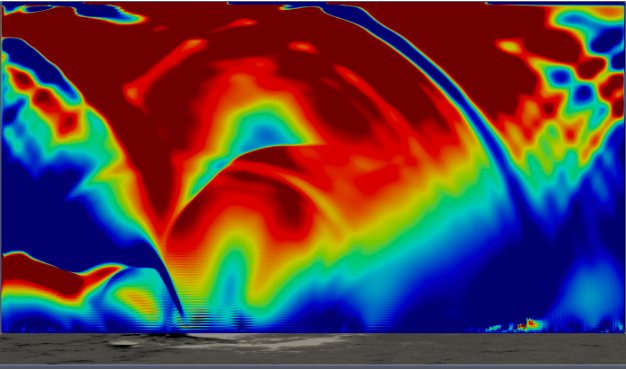NLFFF calculations of the solar coronal magnetic field based on Hinode observations
JAXA Supercomputer System Annual Report February 2022-January 2023
Report Number: R22EU0912
Subject Category: Space and Astronautical Science
- Responsible Representative: Yoshifumi Saito, Institute of Space and Astronautical Science, Department of Solar System Sciences
- Contact Information: Toshifumi Shimizu(shimizu.toshifumi@jaxa.jp)
- Members: Yusuke Kawabata, Toshifumi Shimizu, Kouhei Teraoka
Abstract
Our study focuses on understanding of the mechanism responsible for the occurrence of the solar flares. We derive 3D magnetic field structure in the corona by performing a 3D magnetohydrodynamics simulation using vector magnetic field maps mainly acquired with the Hinode spacecraft. We investigate 3D magnetic field structure formed in the solar atmosphere responsible for the occurrence of solar flares.
Reference URL
Please refer to ‘ひのでプロジェクトのホームページ:TOP PAGE‘.
Reasons and benefits of using JAXA Supercomputer System
We perform 3D magnetohydrodynamics numerical simulations by using vector magnetic field data acquired with the Hinode spacecraft in order to derive 3D magnetic field structures in the solar corona. We need large computational resource in order to perform three-dimensional magnetohydrodynamics simulations.
Achievements of the Year
For understanding the processes from energy build-up to trigger and plasma eruption in solar flares, it’s essential to evaluate quantitatively the temporal evolution of photospheric magnetic field distributions and its coronal consequences. Reliable observationations of the coronal magnetic fields are unavailable because of poor development of techniques for high precision spectro-spectroscopy and inversion. Alternately, non-linear force free field (NLFFF) modeling has been used with the observed photospheric magnetic field distribution as the boundary condition to extrapolate the field lines to the corona. In this year, we analyzed two large-scale (X-class) flares on 6 September 2017. Using the derived coronal field distribution, we studied the spatial distribution of parameter “decay index” (Figure 1). The index is a height gradient of horizontal magnetic fields, which can be related to Lorentz force that suppresses a flaring magnetic flux rope from expansion. The result shows that we need to identify the location of the magnetic flux rope and current distribution which is required to work Lorentz force, in addition to decay index parameter.

Fig.1: The spatial distribution of “decay index” parameter, which shows the parameter along a slit crossing an eruptive flux robe as a function of the height from the solar surface in the vertical axis.
Publications
– Peer-reviewed papers
Hasegawa, T. and Shimizu, T. “Temporal Behaviros of Magnetic Helicity Injections by Self and Mutual Sunspot Rotations, ” 2023, ApJ, 943, 96 (p12) doi: 10.3847/1538-4357/aca800
Usage of JSS
Computational Information
- Process Parallelization Methods: MPI
- Thread Parallelization Methods: N/A
- Number of Processes: 16
- Elapsed Time per Case: 3.5 Hour(s)
JSS3 Resources Used
Fraction of Usage in Total Resources*1(%): 0.03
Details
Please refer to System Configuration of JSS3 for the system configuration and major specifications of JSS3.
| System Name | CPU Resources Used(Core x Hours) | Fraction of Usage*2(%) |
|---|---|---|
| TOKI-SORA | 790759.00 | 0.03 |
| TOKI-ST | 0.00 | 0.00 |
| TOKI-GP | 0.00 | 0.00 |
| TOKI-XM | 0.00 | 0.00 |
| TOKI-LM | 0.00 | 0.00 |
| TOKI-TST | 0.00 | 0.00 |
| TOKI-TGP | 0.00 | 0.00 |
| TOKI-TLM | 0.00 | 0.00 |
| File System Name | Storage Assigned(GiB) | Fraction of Usage*2(%) |
|---|---|---|
| /home | 40.00 | 0.04 |
| /data and /data2 | 2750.00 | 0.02 |
| /ssd | 300.00 | 0.04 |
| Archiver Name | Storage Used(TiB) | Fraction of Usage*2(%) |
|---|---|---|
| J-SPACE | 0.00 | 0.00 |
*1: Fraction of Usage in Total Resources: Weighted average of three resource types (Computing, File System, and Archiver).
*2: Fraction of Usage:Percentage of usage relative to each resource used in one year.
ISV Software Licenses Used
| ISV Software Licenses Used(Hours) | Fraction of Usage*2(%) | |
|---|---|---|
| ISV Software Licenses(Total) | 0.00 | 0.00 |
*2: Fraction of Usage:Percentage of usage relative to each resource used in one year.
JAXA Supercomputer System Annual Report February 2022-January 2023


